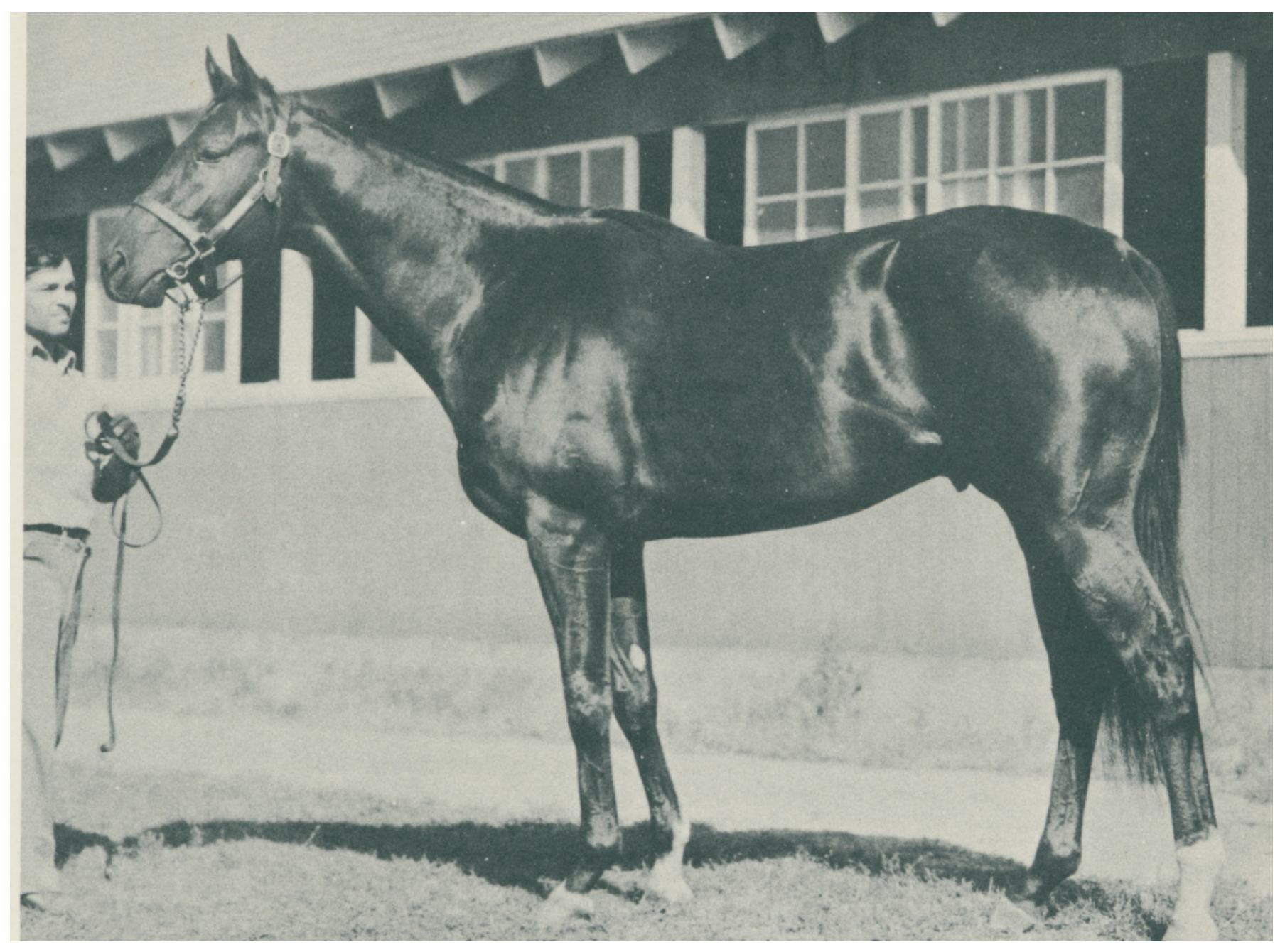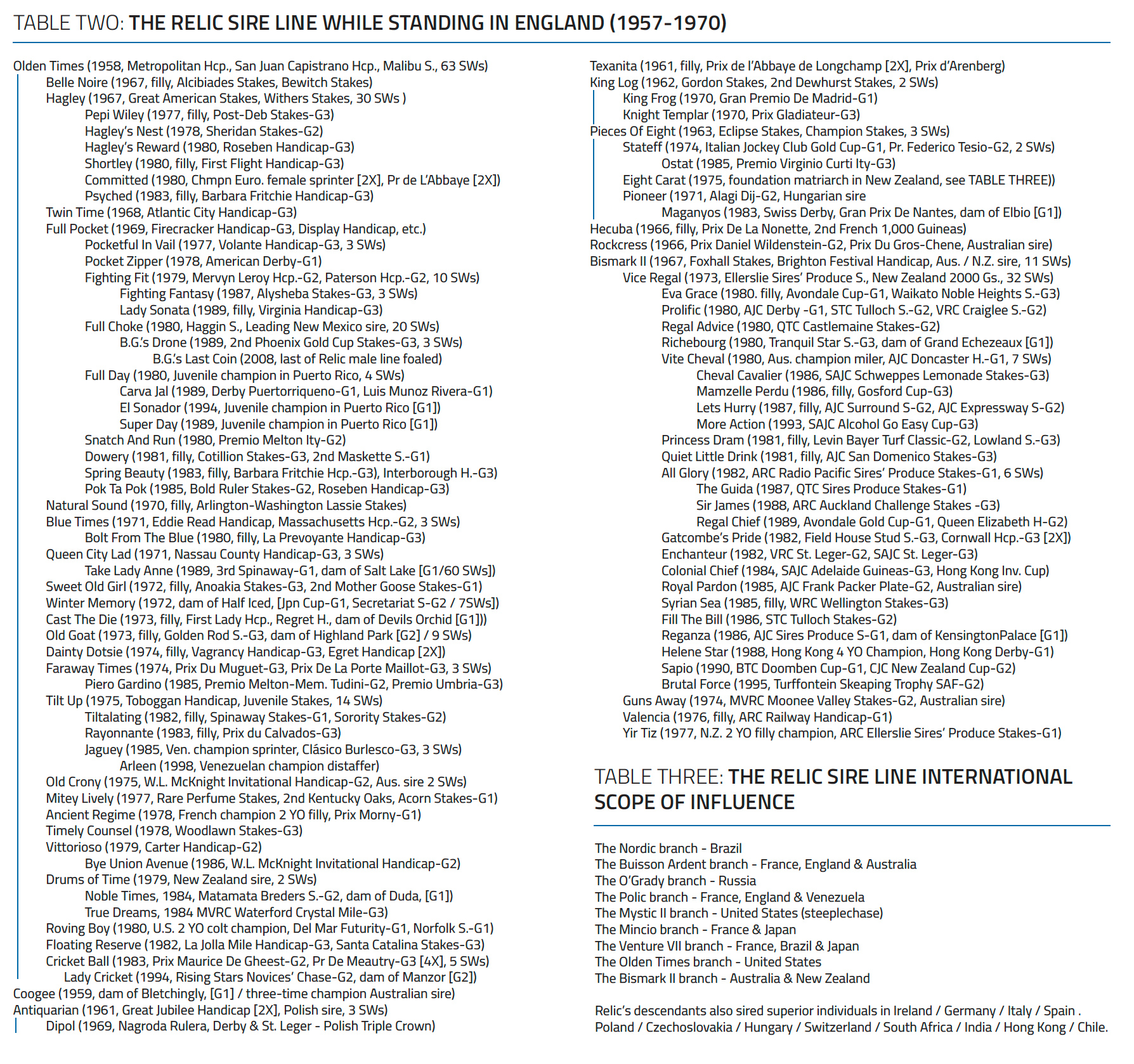Man o’ War’s grandson Relic was the first of his kind to cross the Atlantic and create a remarkable influence on the European thoroughbred which soon spread globally to include a profound effect on Australasia.
England’s highly controversial Jersey Act of 1913 was enacted in response to the marked influx of American horses into Great Britain after anti-betting legislation threatened to cripple the U.S. racing and breeding industry. Many of the American horses at the time carried the blood of sixteen-time leading sire Lexington (USA) whose maternal pedigree included elements that were considered untraceable to ancestors in the General Stud Book. As such, they were stigmatized as “half-bred” and barred from any sort of a breeding career. In reality, it was an action largely taken to protect the British racehorse market. The harsh regulation was enforced all the way to June of 1949 when the accumulation of racing success by ineligible runners combined with the growing desire among British and Irish breeders to have access to the “impure” blood of French thoroughbreds led to its repeal.
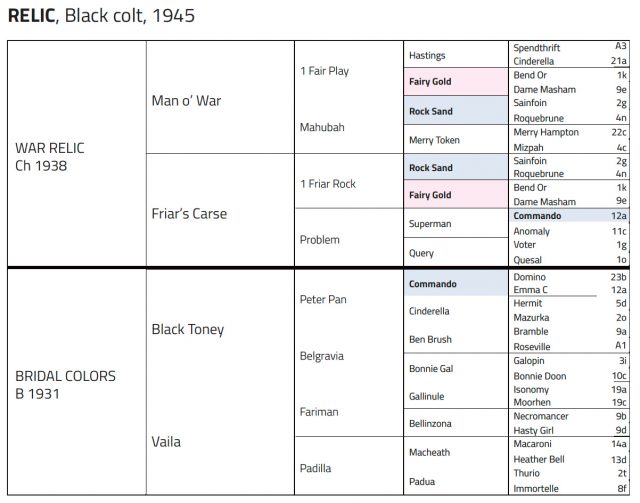 In retrospect, the American sire line that appears to have been most hindered by the Jersey Act was that of Man o’War (USA; 1917) whose great grandsire, Spendthrift (USA), was out of a Lexington mare. Other than this tail-male ancestor, Man o’War’s pedigree was entirely English in origin, only adding to the notion that some of his better sons figured to cross well with the appropriate choice of broodmares in England and Ireland. And, of course, turf racing was unavailable in America during this time period.
In retrospect, the American sire line that appears to have been most hindered by the Jersey Act was that of Man o’War (USA; 1917) whose great grandsire, Spendthrift (USA), was out of a Lexington mare. Other than this tail-male ancestor, Man o’War’s pedigree was entirely English in origin, only adding to the notion that some of his better sons figured to cross well with the appropriate choice of broodmares in England and Ireland. And, of course, turf racing was unavailable in America during this time period.
Under the circumstances, the only son of Man o’War to be exported for any sort of a stud career was Tsukitoma (Jpn; 1932), a foundation stallion in Japan who sired six classic winners (on turf) while ranking among the top five Japanese sires every year between 1946 and 1953 and a champion broodmare sire four times. Another rare instance of grass form was Man o’War’s son, Battlefield (USA) who crossed the Atlantic in 1938 to capture the world’s premier steeplechase event, the Grand National at Aintree.
As such, Man o’War’s paternal grandson Relic (USA) was the first representative of the Man o’ War sire line to stand in Europe following the Jersey Act’s repeal.
Taking it a major step further, no American-bred stallion standing in Europe over the next two decades (1950s and 60s) enjoyed as much of an impact on breeding. Relic, in fact, could easily be considered one of the most underrated thoroughbred influences of the 20th century.
Bred by Col. Edward R. Bradley at his famed Idle Hour Stock Farm in Lexington, Kentucky, Relic was foaled in 1945. He was a black colt measuring 16.1 hands upon maturity. His sire, War Relic (USA) was a very good three-year old whose best race was the Narragansett Special when beating 1941 Triple Crown winner Whirlaway (USA). War Relic had a demonic disposition which included the killing of his groom. Fortunately, there is no recorded evidence this fearsome trait was passed to our subject.
Relic was out of the unrated mare Bridal Colors (USA), a three-quarter sister to Blue Larkspur (USA) an American Racing Hall of Famer as well a breed shaping sire and broodmare sire.
Relic was sold to Charles W. Moore of Circle M Farm from the syndicate who acquired all of Bradley’s thoroughbred related holdings following his death in 1946.
It did not take very long for Relic to show himself to be a brilliant two-year old. His victories included the six and one-half furlong Hopeful Stakes, Saratoga Race Course’s marquis event for juvenile colts. By the end of the year, he ranked second on the Experimental Free Handicap, three pounds less than Citation (USA). The latter, of course, went on to capture the 1948 Triple Crown and is considered by most turf historians as one of the top three American racehorses of the twentieth century, along with Secretariat (USA) and Relic’s grandsire, the immortal Man o’War (USA).
At age three, Relic started the year winning the six furlong Hibiscus Stakes and the seven furlong Bahamas Handicap, at Florida’s Hialeah Park. Soon thereafter, the colt wrenched his back, an injury much more serious than first thought. Not only did it bring Relic’s sophomore season to an abrupt end, all attempts at a comeback at age four proved unsuccessful. The colt had to be retired without ever starting again. In all, his career lasted just seven starts with five wins and two seconds.
Relic’s true black coat color has always been exceptionally rare in thoroughbred populations. It is a Mendelian recessive trait that usually skips several generations before reappearing. In Relic’s case, his black coat traces back to Trumpator (1782; GB), the grandson and tail-male heir to the great foundation stallion Matchem (GB). Relic is, therefore, a twelfth generation tail-male descendant of Trumpator from whom he inherited his striking and uncommon coat color.
Relic entered stud at his owner’s farm located in Galloway, Ohio in 1950 with a stud fee of $1,000. In retrospect, it is a bit of a surprise that his first and only American crop was as small as it was mediocre. The Circle M Farm property would ultimately become part of legendary Darby Dan Farm, future home to Ribot, Sea-Bird II, Roberto and other highly influential sires.
After just a year, Relic was purchased by Francois Dupre and transferred to his Haras d’Quilly in the Normandy region of France. There he enjoyed a remarkable stint of six seasons (1951-1956) getting winners and later producers of the highest class. His most important descendants, listed by generation, are shown in Table One. Between 1956 and 1960, Relic was ranked among the top five leading French sires four times. In 1957, he ranked second. Between 1961 and 1966, Relic was ranked among the top six leading French broodmare sires every year. In 1965, he was France’s champion broodmare sire.
Relic’s final fourteen years (1957-1970) were spent in England at Longholes Stud near Newmarket. There, while not quite as consistent as his French years, he continued to sire superior individuals both as runners as well as producers. Relic’s most important descendants during this period are listed in Table Two. His best year came in 1966 when he was ranked third among the leading English sires. He died at the age of twenty-five in December of 1970.
From a total of 380 foals over twenty-one crops, the American transplant sired 34 (9%) stakes winners. Relic (whose own sire, War Relic was closely inbred) seemed to do best with inbred broodmares particularly those who were inbred to influential mares.
In his book, “Typology of the Racehorse” famed breeding analyst Franco Varola classified Relic to be a member of his ‘Floating Series’ of chefs-de-race, claiming the stallion to be one of the closest to attaining full status – that of a Pure Brilliant chef-de-race.
In a remarkable expression of extreme speed, Relic and his offspring were paramount in the production of France’s best winners at the shortest of distances during his primary period of domestic influence. The results are as follows:
1) Between 1957 and 1965, Relic and his progeny produced the winners of seven of the nine winners of the Prix De l’Abbaye de Longchamp (for 2 YOs & up; now G1) run at 1,000 meters at Longchamp.
2) Between 1955 to 1965, Relic and his sons
sired eight of the ten winners of the Prix Du Petit Couvert (for 3 YOs & up; now G2) run at 1,000 meters at Longchamp.
3) Between 1958 and 1964, Relic and his progeny produced five of the seven winners of the Prix Du Gros-Chene (for 3 YOs & up; now G2) run at 1,000 meters at Chantilly.
4) Between 1957 and 1965, Relic and his progeny produced six of the nine winners of the Prix Saint-Georges (for 3YOs & up; now G3) run at 1,000 meters at Longchamp.
5) Between 1954 and 1964, Relic and his progeny produced seven of the eleven winners of the Prix d’Arenberg (for 2 YOs & up; now G3) run at 1,100 meters at Longchamp or Chantilly
In other words, from the mid-1950s to the mid-60s, Relic’s offspring as well as those of his sons and daughters completely dominated the majority of major French fixtures at five furlongs, particularly those run at Longchamp and Chantilly, two of France’s premier racetracks.
It is certainly unusual for a newly introduced sire line to show such dominance at a specific distance within a major domestic center of racing for an entire generation of time.
Relic was also known for his ability to get top quality milers. This is reflected by the average winning distance among his progeny of 8.66 furlongs. The best of his milers included Buisson Ardent and Mincio whose victories at eight furlongs included the Poule d’assai Des Poulains (French Two Thousand Guineas). Venture VII was a winner of the Sussex and St. James Palace Stakes, two of England’s biggest mile venues. His best son, Olden Times captured the Metropolitan Handicap which at the time was America’s premier event at a mile.
As such, Relic is thought of as a superior sire of sprinters and milers. And yet, he was also capable of getting runners of the highest order at some of the longest of thoroughbred distances. The highly versatile, Olden Times captured the San Juan Capistrano Handicap at Santa Anita Park, America’s longest grass race in America at a mile and three-quarters. In France, Blockhaus won the Prix Henri Foy (a major prep for the Prix De l’Arc De Triomphe) at 2,300 meters (a mile and seven-sixteenths).
The Relic sire line became exceedingly far-reaching in its global spread over a relatively small number of generations. Table Three demonstrates its international scope of influence.
Relic’s primary conduits to contemporary pedigrees include:
1) His daughter Relance (Fr.) who foaled the full brothers Reliance (Fr.) and Match II (Fr.) as well as their three-quarter brother Relko (GB), all major winners in England and / or France. Relko occasionally appears in contemporary pedigrees but it is Reliance II who is, by far, the most common conduit of this trio serving as broodmare sire to the influential sires Kris (GB), Diesis (GB). Reliance II is also the broodmare sire of Surumu (Ger.), a six-time champion sire in Germany.
2) His son Buisson Ardent (Fr.), grandsire to Rory’s Rocket (GB) who foaled Rory’s Jester, an Australian juvenile champion and a successful local sire who appears in the pedigrees of numerous contemporary Australasian sires and dams.
3) His daughter Ranavalo (Fr.) was the dam of top French sprinter Fortino II (Fr.) who sired chef-de-race Caro (Ire.) a French classic winner and champion sire. Caro’s tail-male line connects the important American sires In Excess (Ire.), Indian Charlie (USA) and Uncle Mo (USA).
He is also broodmare sire to a number of noteworthy stallions including sire-of-sires Unbridled’s Song (USA).
4) His son Olden Times was the sire of Square Generation (USA), the third dam of American Hall of Famer and sire-of-sires Awesome Again (USA).
5) His daughter Coogee (GB) was the dam of Group One winner Bletchingly, a three-time Australian champion sire who continues to appear regularly in a wide array of pedigrees Down Under.
6) His son Pieces of Eight (GB) was the sire of foundation matriarch Eight Carat (GB), a Broodmare of the Year in New Zealand for three consecutive years (1995-97). Unplaced in five career starts while never earning a penny, Eight Carat produced a record five Group winners. Table Four demonstrates the sixteen stallions descending from the Eight Carat family who sired at least one Group stakes winner. They combined to sire a total of 39 Grade 1 stakes winners. The list includes 1995-96 Australian Horse of the Year Octagonal (NZ, by Zabeel)) who became the only Horse of the Year to sire a Horse of the Year, his son, Lonhro, a champion miler who also was champion Australian sire in 2003-04. It also includes Commands, by Danehill, sire of thirteen Group One winners and leading sire by winners for three consecutive seasons.
7) His son Bismark II (GB), sire of the New Zealand foundation sire Vice Regal whose superior male line descendants are listed in Table Two.
Relic’s widespread influence on the Australasian thoroughbred
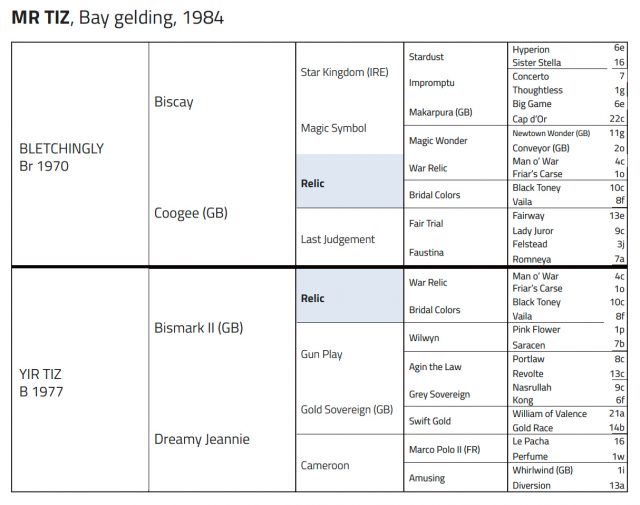 Relic’s contemporary impact on the pedigrees of Australasian thoroughbreds exceeded even those of Europe where he spent the large majority of his time at stud. As demonstrated in the previous section, three of his seven primary conduits exert their influence in Australia and / or New Zealand.
Relic’s contemporary impact on the pedigrees of Australasian thoroughbreds exceeded even those of Europe where he spent the large majority of his time at stud. As demonstrated in the previous section, three of his seven primary conduits exert their influence in Australia and / or New Zealand.
Australia’s champion sires who transmit Relic blood include Bletchingly (1979-80, 1980-81 & 1981-82), Redoute’s Choice (2005-06, 2009-10 & 2013-14), Lonhro (2010-11) and Snitzel (2016-17, 2017-18, 2018-19, 2019-20).
An examination of Blueblood’s 2020 stallion directory shows that of the 145 listed sires, 97 of them convey Relic somewhere in their pedigree, a remarkable 67% clip.
As noted above, Relic’s influence was well proportioned between his sons and daughters. This tends to facilitate patterns of inbreeding that demonstrate sex balancing. Between 1977 and 2006, there were a total of sixteen Australasian Group 1 winners inbred 5X5 or closer to Relic. The best known of these was Mr. Tiz. This gelded son of Bletchingly and a member of the New Zealand Racing Hall of Fame was inbred, 3X3, to Relic. His seven career Group One victories included New Zealand’s premier sprint event, the 1,200 meter ARC Railway Handicap (three times), the 1,200 meter WRC Telegraph Handicap (NZ; twice), the 1,100 meter ATC The Galaxy Handicap (NZ) and the 1,400 meter Waikato Sprint (NZ). This was a body of work certainly consistent with an individual closely inbred to our ancestral subject.
End of the line
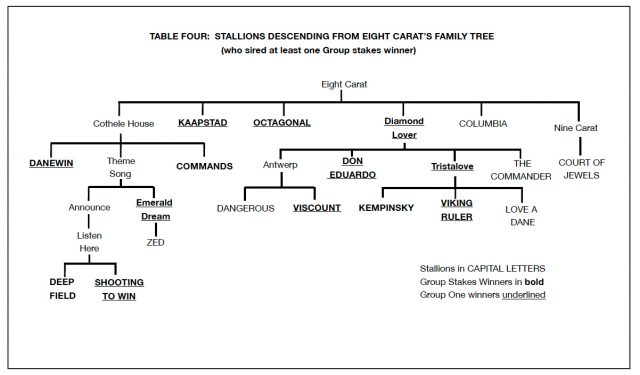 Despite Relic’s evergreen influence within the interior of contemporary pedigrees, his own tail-male line that enjoyed global prominence from the early 1960s into the mid-90s now stands on the brink of extinction. What was, by far, the strongest branch of the Man o’War line now finds itself on the verge of complete termination.
Despite Relic’s evergreen influence within the interior of contemporary pedigrees, his own tail-male line that enjoyed global prominence from the early 1960s into the mid-90s now stands on the brink of extinction. What was, by far, the strongest branch of the Man o’War line now finds itself on the verge of complete termination.
Much of this has been caused by the same tsunami that has washed away so many of thoroughbred history’s greatest stirps: what Franco Varola referred to as “the Phalaris revolution”. The mega-line of Phalaris now comprises roughly 95% of all sire lines.
The last male line descendant of Relic derives from the American branch of Olden Times. The latter’s son Full Pocket (USA) gave rise to leading New Mexico sire Full Choke (USA) who, in turn got the sprinter and moderate producer B.G.’s Drone (USA). That one’s final colt was ironically named B.G.’s Last Coin (USA), foaled in 2008.
When B.G.’s Last Coin, who is currently twelve years of age and without any known progeny, takes his last breath the Relic sire line will have come to its official end.
The expiration of a once great source of class and speed.


